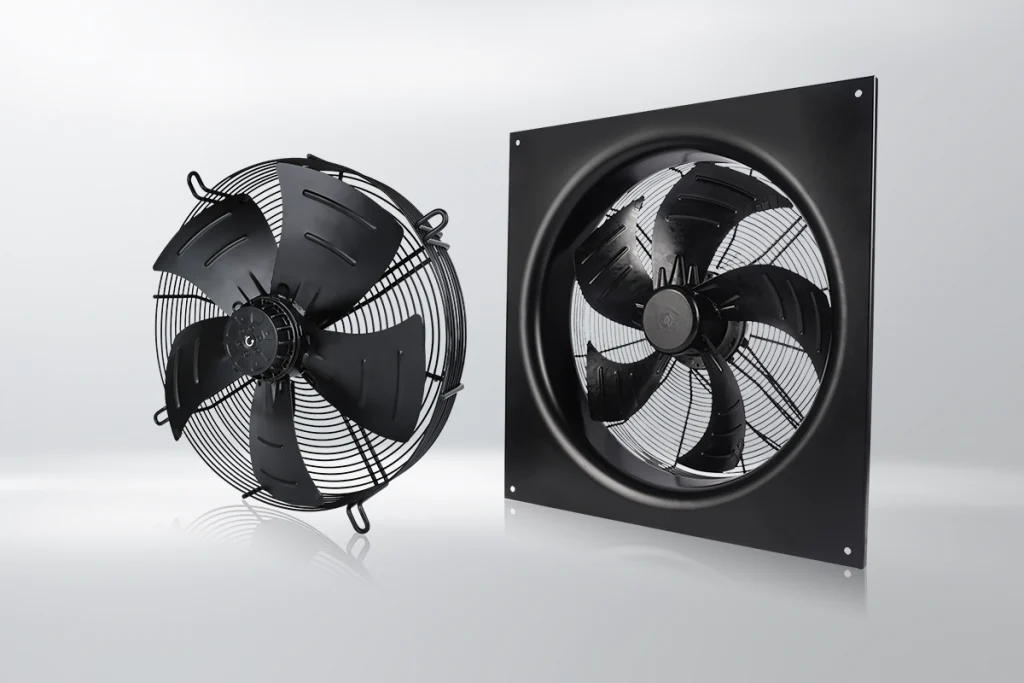
What are Axial Fans Best Suited For?
Axial fans are commonly used in various applications, but their design makes them particularly ideal for specific environments and systems. This article delves into the industries and uses where axial fans are most effective, focusing on their technical advantages, performance benefits, and real-world applications.
Axial Fans: A Quick Overview of Their Design and Functionality
Axial fans move air along the axis of the fan. These fans consist of a rotor and blades mounted on a shaft, which rotates to push air in a direction parallel to the axis of rotation. The fan’s efficiency and airflow make it ideal for applications requiring large volumes of airflow with moderate pressure needs.
The key feature of axial fans is their ability to move a substantial amount of air at lower pressures. This makes them optimal for cooling, ventilation, and air circulation in various settings.
Industrial Applications of Axial Fans
Axial fans shine in industrial environments, where large-scale air movement is crucial. They are commonly used in:
- HVAC Systems: In heating, ventilation, and air conditioning systems, axial fans aid in moving air through ducts, keeping temperature regulation efficient.
- Power Plants: In both thermal and nuclear power plants, axial fans are key components in cooling systems, ensuring machinery stays within safe operating temperatures.
- Industrial Ventilation: In manufacturing facilities, axial fans are used to remove heat, smoke, fumes, and dust, improving air quality and safety for workers.
- Agricultural Ventilation: Axial fans are also used in poultry farms and greenhouses to circulate fresh air, regulate humidity, and maintain ideal conditions for livestock and crops.
These industries benefit from axial fans because of their capacity to handle large volumes of air efficiently, which is essential for maintaining effective operations in such high-demand environments.
Axial Fans in Commercial and Residential Use
While axial fans are primarily used in industrial settings, their applications also extend to commercial and residential spaces. In these environments, axial fans are used for:
- Cooling Systems: Axial fans provide efficient cooling in commercial air conditioning units, helping maintain comfortable indoor environments in offices, shopping centers, and hotels.
- Home Ventilation: In homes, axial fans are used in exhaust systems to remove moisture, odors, and pollutants, ensuring air quality in kitchens, bathrooms, and laundry rooms.
- Computing Systems: Many computing devices, including servers, rely on axial fans to prevent overheating and maintain reliable performance.
In these use cases, axial fans help improve energy efficiency, reduce operating costs, and ensure comfortable environments.
Key Benefits of Axial Fans
To understand why axial fans are best suited for specific applications, let’s consider the main benefits they provide:
- High Airflow Efficiency: Axial fans are engineered to move large amounts of air with minimal power consumption, making them efficient for cooling and ventilation systems.
- Compact Design: Their smaller form factor makes axial fans a great choice for installations in tight spaces where large amounts of airflow are still required.
- Versatility: Axial fans are used across various industries, from cooling towers to industrial exhaust systems, offering flexibility for a wide range of applications.
- Cost-Effectiveness: With their efficiency and minimal maintenance needs, axial fans provide a budget-friendly solution for both commercial and industrial environments.
Technical Features that Make Axial Fans Ideal for Specific Applications
The technical characteristics of axial fans help explain why they are ideal for certain uses. Here are some key aspects:
- Blade Angle and Design: The design of the fan blades influences airflow and pressure. Axial fans typically feature blades at angles optimized for low to medium-pressure systems.
- Motor Speed: Axial fans are built to operate at high speeds for continuous use, providing consistent and stable airflow.
- Durability: Built from corrosion-resistant materials such as stainless steel, axial fans are designed to last, even in challenging environments.
These technical specifications contribute to the reliability and long service life of axial fans, making them ideal for high-demand applications.
Comparing Axial Fans to Centrifugal Fans
Axial fans are not the only type of fan available. Centrifugal fans are often used for applications that require higher pressures or more directional airflow. Here’s a quick comparison:
- Airflow: Axial fans excel at moving large volumes of air at low pressure, while centrifugal fans perform better in high-pressure environments.
- Energy Efficiency: For low-pressure applications, axial fans are generally more energy-efficient than centrifugal fans.
- Size and Design: Axial fans are more compact, while centrifugal fans tend to be bulkier and more complex.
This comparison helps in deciding which fan type is better suited to different needs.
Conclusion: Maximizing the Benefits of Axial Fans
Axial fans are best suited for applications that require high-volume airflow with moderate pressure. Their design allows for effective ventilation, cooling, and air circulation in both industrial and residential environments. With their technical advantages, cost-effectiveness, and versatility, axial fans are essential for a variety of air management systems.
In industries like HVAC, power plants, agriculture, and commercial cooling, axial fans deliver superior performance, efficiency, and durability. When selecting the right fan, it’s important to evaluate specific requirements for airflow, pressure, and space to maximize the benefits of an axial fan.
